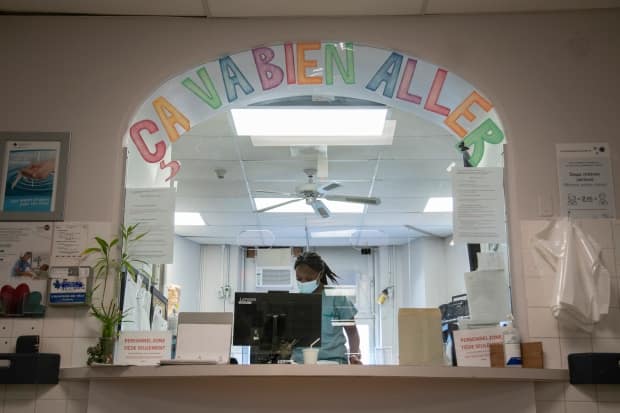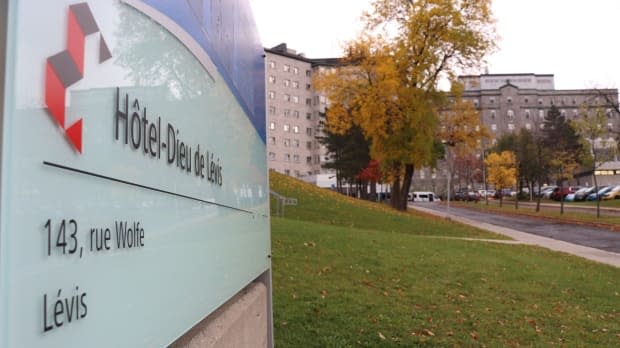As COVID-19 cases mount in Quebec's regions, some hospitals may be nearing a tipping point
The hospital in Maria, Que., constructed in 1954, is one of at least four civic institutions in town of 2,500 currently grappling with a COVID-19 outbreak.
The hospital, which has 82 beds, serves a population of about 33,000 people in an area that has some of the highest per capita infection COVID-19 infection rates in the province.
The way the second coronavirus wave has washed over the Gaspé area illustrates how quickly things can go wrong in Quebec's outlying regions.
In the Gaspé, as in other far-flung parts of the province, community spread has taken root within tightly knit, socially active populations.
There are fraying health infrastructures. There is a shortage of health-care workers — and the ones who are on the job in facilities such as the Maria hospital say they're exhausted.
The cramped building has been updated over the years, but even Premier François Legault described its emergency ward as "dysfunctional and dilapidated" when he passed through town in July.
The main intake department is a corridor that is only about three metres wide. Hospital beds line one of the walls; some are separated from passing traffic by a curtain.
A union representing paramedics in the region has expressed concern that asymptomatic COVID-19 patients could spread the virus in that part of the hospital.
"Everyone passes through the same place," said André Tremblay-Roy, vice-president of the union and himself a paramedic who transported patients to the hospital last weekend. "The emergency ward is really dated."

Bricks and mortar buildings are one concern, but the main issue in the Gaspé, as everywhere else, is people.
"The challenge is human resources … but we had a challenge before COVID," said Connie Jacques, vice-president and director-general of the CISSS Gaspésie, the local health authority.
With staff resigning, sick with COVID-19, resources are stretched
During the pandemic's first wave, 13,500 health-care workers provincewide were infected, according to a study conducted by the provincial public health research agency. That represented one-quarter of all cases.
Orderlies and nursing assistants accounted for 70 per cent of cases among health-care workers, partly because nearly half the cases were in long-term care facilities. Almost one-third of those 13,500 workers were in hospitals.
In the Gaspé, the local nurses federation and the union representing orderlies, maintenance and kitchen workers are both reporting members resigning in bunches. Others are sick with COVID-19.
Because the numbers in the regions are all smaller — the main COVID-19 hospital in Gaspé has 10 beds set aside for coronavirus patients — every absence or empty position has an impact.
"When one person goes out it makes a big difference," Jacques said.
The result is having to move staff, and sometimes patients, around within the system. That's one of the ways the pandemic spread through the CHSLD network in and around Montreal last spring.
Union leaders say it's happening again — this time in the regions.
"We're at the stage now that the major centres were in last spring," said Pierre-Luc Boulay, president of a union that represents orderlies and support workers in the Gaspé.
The health authority says workers are moved only when it's "absolutely necessary."
The big-city bottleneck
Eastern Quebec has a safety net of sorts: if someone becomes severely ill, they are typically sent first to Rimouski, and in dire cases to Quebec City's Heart and Lung Institute or the Hôtel-Dieu Hospital in Lévis.
But Rimouski, Quebec City and Lévis are all seeing their own cases rise, including among health-care workers.

Lévis's Hôtel-Dieu is the treatment centre for acute cases in Chaudière-Appalaches, one of the regions hit earliest and hardest by the second wave. It too is dealing with outbreaks among staff and patients.
One of those patients, a former orderly for the health region named Raphaël Blouin-Durand, provided a discomfiting account of his COVID-19 ordeal to Radio-Canada last week.
When Blouin-Durand started feeling unwell, he first went to his local hospital in Saint-Georges-de-Beauce, where he says he found a similar situation to the one paramedics in Maria describe: non-COVID patients in relative proximity to suspected COVID-19 cases, and staff walking from one zone to another.
"Yes, they were changing and there's a door, but the fact is when the minister says people aren't going from red zones to green zones in the same day, it isn't true," he told Radio-Canada.
When Blouin-Durand's symptoms worsened a few days later, he was taken to Lévis, where he said harried workers were also moving from one zone to the next. He said he was also left unattended at points and could easily have moved around in the hospital despite being diagnosed with COVID-19.
Moving patients recovering from COVID-19
Then there's the problem of what to do with recovering patients. Some CHSLD and seniors' homes don't allow residents return to their rooms until after they've been symptom-free for two weeks.
But in some small, regional hospitals with few beds, recovered patients are moved off the COVID-19 ward well before 14 days have elapsed.
One elderly COVID-19 positive patient in Maria, who suffered from dementia, was turned away by his seniors' residence after leaving the hospital. Regional health officials found him a bed in the town's CHSLD, where he died a few days later. In that case, family members went public with their anger.
Several regions have tried to address those types of problems.
The Chaudière-Appalaches CIUSS has opened a "non-traditional" convalescence ward across the street from the hospital that has 60 beds, roughly one third of which are occupied.
A similar facility has been set up in Saint-Georges, and nearly all of its 19 beds are taken.
Central Quebec grappling with similar problems
In the Mauricie-Centre-du-Québec region, halfway between Montreal and Quebec City, the main COVID-19 intake centre is the Centre hospitalier affilié universitaire régional de Trois-Rivières, where 21 of 40 beds are occupied.
A further 16 beds can be made available in Drummondville, 70 kilometres away, a CISSS spokesperson said.
The worry in Trois-Rivières is the institution is fighting a major outbreak in its neurological unit, with 46 positive cases. Of those, 27 have been detected among staff members.
If one is looking for a sliver of good news in the regional picture, it can be found by looking northward. The Abitibi-Témiscamingue's COVID-19 centre is at 10 per cent occupancy. There are zero COVID-19 patients in intensive care and there are no outbreaks currently being investigated.
Sinking morale among health workers
The additional beds and recovery wards — like other COVID-19 resources in Quebec City, and Gaspé, and Saguenay, and Trois-Rivières and elsewhere in the regions — didn't exist six months ago. Plus, they're being staffed mostly with people who nominally do other jobs.
"It's very, very hard. Morale is very low," said Boulay of the orderlies' union in Gaspé. "More resources are leaving than coming in … people are tired. They're burned out."
The situation in Chaudière-Appalaches is described in similar terms.
"We've had a lot of resignations, people deciding to leave for the private sector because of overwork," said Sonya Leboeuf, vice-president of the union representing professional and administrative workers in Chaudière-Appalaches. "Morale is not good."

In the Saguenay, which is steadily moving up the scale on the province's colour-coded alert map, the local nurse's union is raising the alarm. It contends more and more staff are quitting. The health region reports it is dealing with 23 separate outbreaks.
Local health officials have declared outbreaks in three seniors' residences in recent days, and the Saguenay police service is being ravaged by illness; about one-fifth of the force is currently either infected or in quarantine awaiting test results.
"In two days, we've had 11 hospitalizations," said Julie Bouchard of the Fédération interprofessionelle de la santé du Québec's Saguenay chapter. "We're worried about whether our network here in the Saguenay-Lac-Saint-Jean is going to be able to cope."


